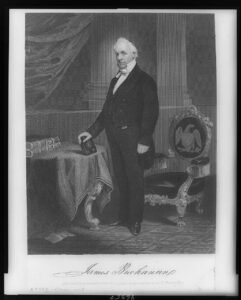




James Buchanan
James Buchanan, the 15th President of the United States, served from 1857 to 1861. His presidency is often remembered for its inability to prevent the secession of Southern states and the onset of the American Civil War. Buchanan’s career spanned various public service roles, including congressman, senator, diplomat, and secretary of state, making him one of the most experienced politicians to ascend to the presidency. This biography explores Buchanan’s life, from his early years to his presidency, and assesses his legacy.
Early Life and Education
Birth and Family Background
James Buchanan was born on April 23, 1791, in Cove Gap, Pennsylvania. He was the second of eleven children born to James Buchanan Sr., a successful merchant and farmer, and Elizabeth Speer Buchanan. The Buchanan family was of Scotch-Irish descent and had emigrated to America in the mid-18th century. They were well-respected in their community and provided young James with a stable and supportive environment (Baker, 2004).
Education and Early Influences
Buchanan’s early education took place at local schools, where he demonstrated a sharp intellect and a strong aptitude for learning. At the age of 16, he enrolled at Dickinson College in Carlisle, Pennsylvania. Despite a brief period of disciplinary trouble and nearly being expelled, Buchanan graduated in 1809 with honors. His experiences at Dickinson helped shape his disciplined and determined character (Klein, 1995).
After graduating, Buchanan studied law under the prominent lawyer James Hopkins in Lancaster, Pennsylvania. He was admitted to the bar in 1812 and quickly established a successful legal practice. His work as a lawyer brought him financial stability and local recognition, laying the groundwork for his future political career (Baker, 2004).
Early Political Career
Entry into Politics
Buchanan’s political career began in 1814 when he was elected to the Pennsylvania House of Representatives as a member of the Federalist Party. His tenure was marked by his advocacy for a strong national government and his opposition to the War of 1812. Although the Federalist Party was in decline, Buchanan’s eloquence and effectiveness as a legislator garnered him attention and respect (Klein, 1995).
U.S. House of Representatives and Senate
In 1820, Buchanan was elected to the U.S. House of Representatives, where he served five consecutive terms. During his time in the House, Buchanan shifted his political allegiance to the Democratic Party, aligning himself with Andrew Jackson’s vision of democracy and states’ rights. Buchanan became known for his oratorical skills and his ability to navigate complex legislative issues (Baker, 2004).
In 1834, Buchanan was elected to the U.S. Senate. His Senate career was distinguished by his support for Jacksonian policies, including opposition to the Second Bank of the United States and advocacy for territorial expansion. Buchanan’s legal expertise and diplomatic demeanor made him a key figure in the Senate, where he served until 1845 (Klein, 1995).
Diplomatic Roles
Buchanan’s diplomatic skills were recognized by President James K. Polk, who appointed him as the U.S. Minister to the United Kingdom in 1845. During his tenure in London, Buchanan successfully negotiated the Oregon Treaty, which settled the boundary dispute between the United States and Britain in the Pacific Northwest. His diplomatic achievements further bolstered his reputation and solidified his status as a leading figure in American politics (Baker, 2004).
Secretary of State
Polk Administration
In 1845, Buchanan was appointed as Secretary of State under President Polk. His tenure was marked by significant accomplishments, including the negotiation of the Oregon Treaty and the management of diplomatic relations during the Mexican-American War. Buchanan’s handling of foreign affairs during this period showcased his adeptness at diplomacy and his commitment to expanding American territory (Klein, 1995).
Presidential Ambitions
By the end of Polk’s administration, Buchanan had emerged as a prominent candidate for the presidency. However, he faced strong competition within the Democratic Party and was ultimately passed over in favor of Lewis Cass in the 1848 election. Buchanan returned to private life in Pennsylvania but remained active in politics, positioning himself for another run at the presidency (Baker, 2004).
Election of 1856
Democratic Nomination
The 1856 presidential election saw the Democratic Party deeply divided over the issue of slavery. Buchanan, who had been serving as Minister to the United Kingdom, was seen as a compromise candidate with broad appeal. He was nominated on the 17th ballot at the Democratic National Convention, defeating rivals such as Stephen A. Douglas and Franklin Pierce (Klein, 1995).
Campaign and Victory
Buchanan’s campaign emphasized his experience and his commitment to preserving the Union. He appealed to both Northern and Southern voters by advocating for popular sovereignty, allowing territories to decide the issue of slavery for themselves. The Republican Party, formed in opposition to the expansion of slavery, nominated John C. Frémont, while the American Party (Know-Nothings) nominated former President Millard Fillmore. Buchanan won the election with 174 electoral votes to Frémont’s 114 and Fillmore’s 8, carrying all but one slave state and several Northern states (Baker, 2004).
Presidency
Domestic Policy
The Dred Scott Decision
One of the most significant events of Buchanan’s presidency was the Supreme Court’s Dred Scott decision in 1857. The Court ruled that African Americans, whether free or enslaved, were not American citizens and had no right to sue in federal court. It also declared the Missouri Compromise unconstitutional, asserting that Congress had no authority to prohibit slavery in the territories. Buchanan supported the decision, believing it would settle the slavery issue once and for all. Instead, it further polarized the nation and intensified sectional conflicts (Klein, 1995).
Kansas Troubles
Buchanan’s handling of the Kansas Territory crisis further damaged his presidency. The territory was embroiled in violent conflict between pro-slavery and anti-slavery settlers, known as “Bleeding Kansas.” Buchanan supported the pro-slavery Lecompton Constitution, which aimed to admit Kansas as a slave state. His administration’s attempt to force its acceptance, despite clear opposition from the majority of Kansas settlers, led to accusations of corruption and favoritism. Congress ultimately rejected the Lecompton Constitution, and Kansas was admitted as a free state in 1861 (Baker, 2004).
Economic Policy
Buchanan’s presidency was also marked by economic challenges, including the Panic of 1857, a financial crisis triggered by bank failures and declining international trade. Buchanan’s response was limited, as he believed in a laissez-faire approach to the economy and opposed federal intervention. His administration’s inability to address the economic downturn contributed to widespread discontent and further weakened his political standing (Klein, 1995).
Foreign Policy
Ostend Manifesto
Buchanan’s expansionist ambitions extended to foreign policy. In 1854, while serving as Minister to the United Kingdom, he co-authored the Ostend Manifesto with two other American diplomats. The document advocated for the acquisition of Cuba from Spain, even suggesting that the United States could seize the island by force if necessary. When the manifesto was leaked to the public, it caused an uproar, particularly among anti-slavery Northerners who feared the addition of another slave state. The controversy over the Ostend Manifesto undermined Buchanan’s foreign policy credibility and further inflamed sectional tensions (Baker, 2004).
Relations with Central America
Buchanan’s administration also faced challenges in Central America, particularly with the adventurer William Walker’s attempts to establish control over Nicaragua. Walker, who sought to create a pro-slavery regime, was initially supported by some American interests. However, Buchanan ultimately denounced Walker’s actions and worked to stabilize the region through diplomatic means. These efforts reflected Buchanan’s cautious approach to foreign intervention, balancing expansionist desires with the need for regional stability (Klein, 1995).
Legacy
Pre-Civil War Tensions
Buchanan’s presidency is often judged harshly due to his inability to prevent the secession of Southern states. His adherence to constitutional principles and belief in states’ rights led him to adopt a passive stance as Southern states began to secede following Abraham Lincoln’s election in 1860. Buchanan believed that while secession was illegal, the federal government had no authority to coerce states back into the Union. This indecisiveness and lack of strong leadership during a critical period are seen as key failures of his presidency (Baker, 2004).
Views on Slavery
Buchanan’s views on slavery were complex. He personally opposed slavery and considered it morally wrong, but he also believed it was protected by the Constitution and that any action to abolish it should come from the states, not the federal government. This position placed him at odds with the growing abolitionist movement in the North and failed to placate pro-slavery advocates in the South. His support for the Dred Scott decision and the Lecompton Constitution further tarnished his legacy and contributed to the deepening national crisis (Klein, 1995).
Post-Presidency
After leaving office in March 1861, Buchanan retired to his estate, Wheatland, in Lancaster, Pennsylvania. He remained largely out of the public eye during the Civil War, although he defended his administration’s policies in his memoir, Mr. Buchanan’s Administration on the Eve of the Rebellion, published in 1866. Buchanan lived a quiet life, spending his remaining years corresponding with friends and reflecting on his long career in public service (Baker, 2004).
Buchanan died on June 1, 1868, at the age of 77. He was buried in Woodward Hill Cemetery in Lancaster, Pennsylvania. Despite his extensive experience and service to the nation, Buchanan’s presidency is often ranked among the least effective in American history. His inability to address the escalating sectional tensions and his failure to provide decisive leadership during a critical period are significant factors in this assessment (Klein, 1995).
Final Summary
James Buchanan’s life and presidency are emblematic of the complexities and challenges of leading a nation on the brink of division. From his early years in Pennsylvania to his tenure in the White House, Buchanan’s career was marked by dedication, experience, and a commitment to the principles he believed in. However, his inability to navigate the nation’s sectional crisis and his passive approach to the issue of secession ultimately overshadowed his many years of public service. Buchanan’s legacy serves as a reminder of the difficulties of leadership during one of the most turbulent periods in American history.
References
Baker, J. S. (2004). James Buchanan. Times Books.
Klein, P. (1995). President James Buchanan: A Biography. Pennsylvania State University Press.